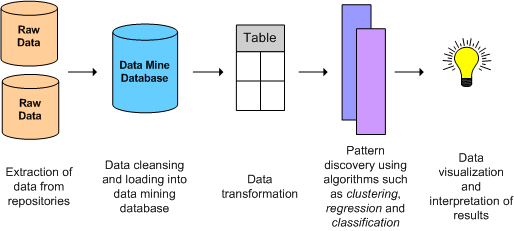Data Mining or Knowledge Discovery in Databases (KDD) has become one of the most path-breaking technologies for businesses and researchers in different industry verticals. With the tremendous increase in the availability of massive, complex data from different sources, companies are facing challenges in structuring big data. However, analysts are focusing their attention on different areas like statistics, machine learning, pattern recognition, databases, and high-performance computing to solve different data mining problems.
Companies are carrying out Data Mining operations through different types of Data Mining software’s and techniques. Extracting data from websites has helped companies gain crucial business intelligence and help companies make important business decisions.

Today, many companies are facing challenges in data mining operations like data aggregation and reporting, distributed data mining and multi-agent data mining, sequence data and time-series data and dealing with unbalanced and cost-sensitive data. Data mining is a challenging job, as the algorithms used in data mining operations can be complex. Moreover, data is not always available at a single location and needs to be extracted from different data sources. There can be issues due to diverse data types and performance-related technicalities.
Businesses willing to tap the immense potential of data services can greatly benefit from PromptCloud’s Web Data Scraping services as per specific business requirements. Our web-based crawling and data extraction services help in extracting and processing relevant business data efficiently and intelligently. We help clients select the best approach for their needs using machine learning and supervised training. PromptCloud automates the whole data extraction process, offering you clean, structured data in the form of XML, CSV or XLS as per your specific requirements.

Data Mining and Analysis is about handling this extracted data and analyzing trends to ensure better decision making. With the big data revolution, data mining principles that have existed for many years are not relevant anymore. Extensive data mining techniques are required to deal with the voluminous amount of data exchanged across the world on a daily basis. Large data sets need to be tackled with attention to detail, addressing customer requirements in a better manner. Business-driven requirements are changing the scenario by leveraging complex data mining techniques instead of a simple ones.
Data Mining involves an in-depth analysis of data, discovery in databases and model-building. Analysts need to possess in-depth knowledge regarding the association and clustering of data to form relevant data patterns before drawing any conclusion. There may be alterations in identifying data sources and formats even after analysts reach any outcome.
Several data mining techniques are available to choose from, including processing model, query model and data collection techniques. Depending on your business model and compatibility with existing software and infrastructure, you can choose from these techniques. Analysts need to analyze different data mining and analytic techniques and solutions and learn how to build them using existing software and solutions.
Data Mining Techniques Data Analysts Use in their Projects
Classification
Classification is a popularly used data mining technique that classifies each item in a data set based on classes or groups. It uses different mathematical techniques such as decision trees, linear programming, statistics and neural network. It identifies attributes of a particular class of customers, items or objects and then classifies a particular item into a relevant set or class.
Clustering
Clustering a makes a useful cluster of objects based on similar characteristics or attributes.
Sequential Patterns
A sequential pattern is a data mining technique used for identifying similar patterns or trends over a period of time.
Association
Association is one of the well-known data mining techniques wherein analysts look for patterns based on purchased items during the transaction. It is mostly used in market basket analysis to analyze customer purchasing patterns.
Prediction
Prediction is one of the data mining techniques to foretell an event based on past events. Several companies are using this technique to predict customers’ future buying patterns and others as well.
Decision Trees
The decision tree is a data mining technique used during the selection criterion. In this technique, a simple question or condition is asked to arrive at two or more answers or choices. Analysts make predictions based on each choice.
Combinations
A combination is used to identify the nearest neighbour by refining your classifications.

Data mining can be performed using modest systems and simple tools, along with appropriate software packages. However, complex data mining requires experience and algorithms compatible with existing software and packages with advanced data mining tools.
Nowadays, an entirely innovative range of tools and systems is required to handle extremely large data sets, clusters and large-scale data processing. Analysts can mine extensive data sets using traditional SQL databases, key or value stores, raw text data and document databases. Clustered databases including Cassandra, Hadoop, CouchDB and Couchbase server do not go with traditional table structure.
Data mining is not just running complex queries on the data that you store in your database. Analysts need to reformat, restructure and analyze data regularly, whether they are using SQL or Hadoop or any other database. Based on the technique and analysis to be done, analysts need to restructure the information. After having the information in the required format, analysts can apply different data mining techniques to data sets.
The future surely belongs to volumes of historical data ruling the future decisions and Data Mining will get smarter and far more sophisticated to give better results. We just have to keep moving with it to make the best use of the data revolution.
Image Credits: dwreview



















































